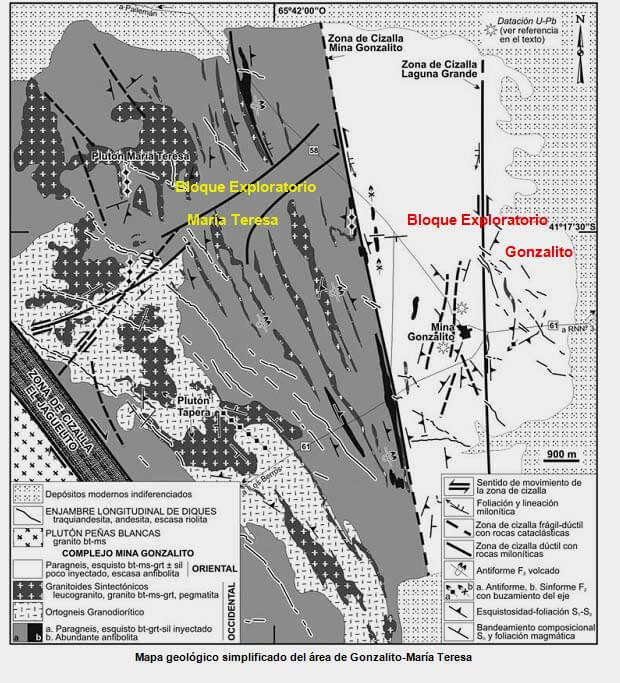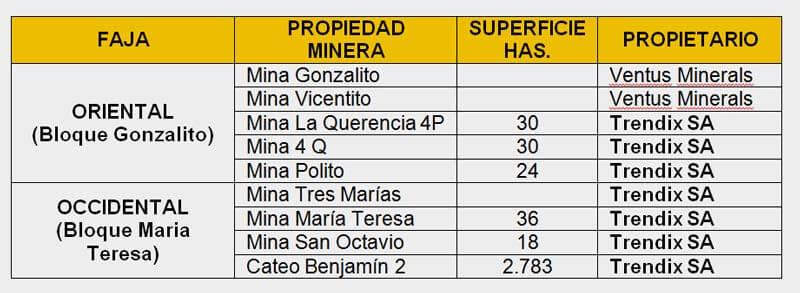Project mineralization is characterized by the presence of Zn - Pb - Ag - Fluorite ( ± In). There are at least two different metallogenic schemes. On the one hand, on the base of the mapping and the structural and mineralogical analysis, the mineralization was interpreted like veins that cut the basement rocks. According to this scheme, the magmatic source related with the hydrothermal activity (meso to epithermal) is posterior at the geological evolution of the basement.
Others researchers had considered that the mineralization of the Gonzalito District is compatible with a stratabound deposit (SEDEX type), with mesosilicic to acidic vulcanism and hydrothermal exhalation associated at the deposition of the sedimentary protolith of the metamorphic rocks. According with this scheme, the magmatic source related with the hydrothermal activity is contemporary with the sedimentation and after both mineralization and wall rock were deformed and metamorphized.
Gonzalito Mine
The ore deposit is represented by several mineralized bodies located along an approximately N-S fracturing line on a distance of about 1,400 m. The host rock consists essentially in a gneiss and anphibolites. The deposit consists in two sections: N section with a N 15º W strike and the S section with a N 15º E strike, probably separated by faulting. On the first one, the mineralized bodies are arranged in "echelon", with lengths till 100 m. In the second, the mineralized bodies are longer, three of them at the - 33 level exceed 100 m.
The total develop of the mineralized bodies for both sections, reach at 825 m. During the exploitation time, were recognized two vertical veins at - 110 and - 140 levels.
The width veins show an average of 60 - 70 cm, but reaching sometimes something more than 1.50 m. Veins are composed mainly by galena (rich in Ag), sphalerite, chalcopyrite, pyrite, quartz.
In depth the mineralization has been enriched in Zn. This data is very important in view of the recent investigations that assigned the presence of Indium linked at Zn.
The average grades untill the - 33 level were: 38 % Pb; 1.2 % Zn and 437 g/tn Ag for vein widths between 0.82 to 1.20 m.
The exploitation of Gonzalito mine started during 1953 and finished in 1980. Production tasks began as open pit until 10 m depth, after began the underground extraction for which were built 20 shafts one of them until 205 m depth. Besides were built 7,000 m of galleries in 6 levels separated between them by 30 m.

The mineral was treated with a flotation plant with 120 tpd capacity. During the period of 1953 - 1979 the plant produced 61,807 tn of lead concentrates and 12,725 tn of zinc concentrates. At San Antonio Oeste town the owner company (Geotécnica SA) had installed a smelting furnace.
La Querencia Mine
Is another of the several veins of this district, located on the south of the Eastern Block, with a visible length of 600 m and at 300 m to the SE of the Gonzalito structure. The vein strike is NNW and width varies between 0,15 to 1.00 m.
The main mineralization is composed by galena, vanadinite, wulfenite, quartz, gypsum. At the property exists 5 open pits with a total development of 1,500 m and a depth of 6 m. Exist besides a shaft of 33 m depth plus 100 m of galleries.
Vicentito Mine
This mine is located around 250 m to the SW of Gonzalito mine. It's a mineralized structure with a extension of 1,100 m. The average width is in the order of 60 cm and contain a mineralization similar at the La Querencia mine.
The tillage is composed by 4 open pits till 7 m depth, one shaft of 40 m and 60 m of galleries.
Polito Mine
This manifestation has only an incipient recognition and is located on the South part of the district.
Maria Teresa Exploratory Block
Include the structures of Maria Teresa, San Octavio and Tres Marías, as well as other manifestations just outcrop and little recognized. These mining properties, totally owned by Trendix SA, are located at the SE of Paileman Hill, at 11 Km to the W of Gonzalito sector. The Benjamin 2 claim cover all the sector.
Maria Teresa consists in two veins (A and B). The last one is the biggest in width and extension. The A vein (N-S strike) has an average width of 22 cm and 250 m length. The B vein reach, in some parts, more than 5 m width.
Tres Marías consist of three main veins, with a visible length of 700 m, untill 3.50 m width and was recognized until 20 m depth.
Hypogenic mineralization is composed by galena, green fluorite, sphalerite, chalcopyrite, pyrite, chalcedony and siderite. Supergenic minerals are chalcosine, bornite, malachite, azurite. Sampling in Maria Teresa showed until 25 % of argentiferous lead.
Sunshine Mining Corp. obtained in 1998, silver grades untill 500 g/t and 3 % Cu from Maria Teresa samples.
Historical labours in Maria Teresa are conformed by 55 m of open pits till 6 m depth and 80 m of galleries. In Tres Marías were opened 120 m of shafts, one of them with 34 m depth; 3,000 m of open pits till 10 m depth and one incline gallery of 50 m over vein.







